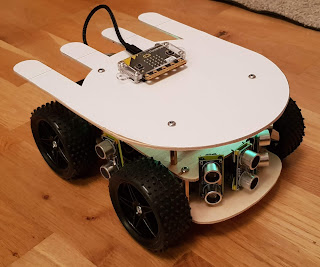The next development saw the Batteries being replaced by 2 x 18650 Li-Ion cells, and the L298N controller replaced by a 4tronix robohat controller, which allowed us to power the Pi and the motors from a single power source. This was lighter and more powerful.
We then ditched the Lego and built a robot from 3mm hand cut acrylic. We decided we didn't like working with acrylic at this point, and also found the design didn't leave enough room for the ultrasonic sensors.
A complete redesign and rebuild in plywood. We could now fit the sensors. We also swapped out the micro metal gear motors for more powerful Pololu ones, and fitted a PiBorg Thunderborg Motor Controller to cope with the larger motor demands. You can't see it here, but between the motors sits an Arduino - used to read data from the sensors. This was the test model we used as the automated software was developed.
As the software was largely done it was time to cut a new chassis - and fit the top to hold the micro:bit. The base is more curved, and the middle section is shaped to position the sensors nicely at 45 degrees. The top is supposed to represent the Sputnik satellite with it's round body and 4 antennae. The top will also be used to hold the various attachments needed for different challenges.
This model was used for the official team photo for the Pi Wars programme.










No comments:
Post a Comment